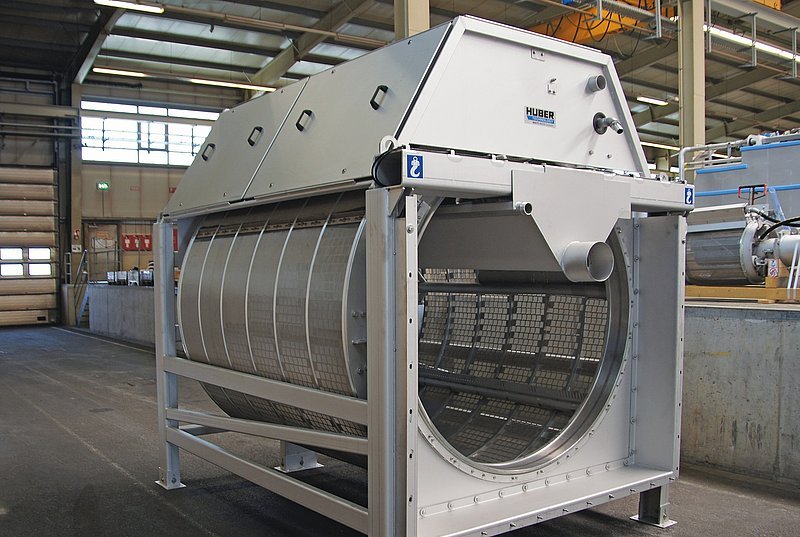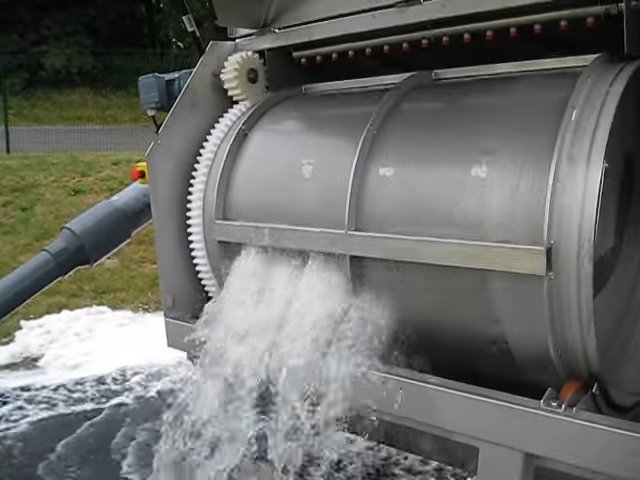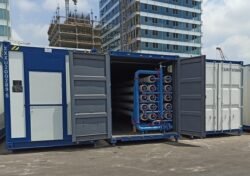
Drum Screen in Wastewater Treatment: Enhancing Solid-Liquid Separation

Drum screens are essential components in modern wastewater treatment facilities. They play a pivotal role by mechanically separating solid waste from the liquid stream at the very beginning of the treatment process. Their primary function is to prevent large debris and particulate matter from entering and potentially damaging subsequent equipment or hindering the effectiveness of the treatment process. Integrating a drum screen within a wastewater management system contributes significantly to the protection of mechanical components and the overall efficiency of treatment operations.
The design of drum screens can vary, but they commonly feature a rotating cylindrical drum partially submerged in the effluent. The wastewater enters the interior of the drum, and as it passes through, the screen captures and lifts solid waste out of the water for disposal. Their design efficiency allows drum screens to handle high flows with excellent solids removal. They are an essential first step in a multistage wastewater treatment system, setting the stage for further processing that may include biological treatment, sedimentation, and filtration.
Operators of wastewater treatment plants rely on drum screens not only for their effectiveness but also for their versatility. They are suitable for various applications, including municipal and industrial wastewater treatment. Furthermore, variations such as rotary drum screens, internally fed rotary drum screens, and those optimized for specific types of waste streams ensure a tailored solution for virtually every screening need. The selection of the appropriate drum screen is determined by the particular characteristics of the influent, including flow rate and solids content, ensuring maximum protection and efficiency for downstream processes.
Basics of Drum Screening in Wastewater
Drum screening is critical in wastewater treatment, leveraging rotary drum screens to remove solids effectively.
Principles of Drum Screening
The critical function of drum screening is to separate waste solids from liquids. This is achieved through a cylindrical drum, typically made from metal or plastic, which rotates to filter the incoming wastewater. As wastewater enters the drum, the rotation causes solids to be captured on the screen. The rotation also assists in moving the separated solids to an area where they are collected for disposal. The size of the openings on the drum’s surface determines the size of particles that are filtered out, a process essential for protecting downstream equipment from damage and blockages.
Types of Drum Screens
There are primarily two types of drum screens used in wastewater treatment:
-
Rotary Drum Screens:
- These are horizontally oriented screens that rotate at a slight angle.
- The interior of the drum is fitted with baffles, or internal filtration panels, to enhance the screening process.
-
Perforated Drum Screens:
- These screens contain uniform holes to filter specific sizes of solids.
- They operate on a similar rotational principle but are distinguished by their perforated design.
Both drum screens are designed to be self-cleaning, utilizing natural gravitational forces, spray water, or mechanical brushes to keep the filtration process efficient and minimize maintenance requirements. The correct selection and sizing of a drum screen depend on factors like flow rate and the nature of the solids present in the wastewater.
Components of Drum Screens
Drum screens are integral to modern wastewater treatment, designed to remove solids from effluent. They must be constructed from durable materials and incorporate efficient mechanisms to withstand the challenging environment of wastewater processing.
Screen Materials
The primary component of a drum screen is the screening material itself, typically consisting of wire mesh or wedge wire. These materials are favored for their strength and ability to form precise gaps to filter out solids. Styl steel is commonly used for its corrosion resistance and longevity, enhancing the drum screen’s durability. Specific designs also employ perforated plates, providing a robust screening option for heavier waste loads.
Drive Mechanism
The drive mechanism ensures the drum screen’s rotation, which is crucial for processing wastewater continuously. This usually comprises trunnion wheels and a motor, which facilitate a smooth and consistent drum rotation. The gears and motors are sized according to the load they must handle, ensuring efficient operation and reducing the risk of breakdowns.
Support Structure
A sturdy support structure is essential for maintaining the drum screen’s integrity over long periods. This framework not only supports the weight of the screen and its contents but also tolerates the forces exerted during rotation and waste processing. The support structure is often constructed from materials such as stainless steel, which provides the necessary strength and resiliency against corrosive wastewater elements.
Installation and Retrofitting
Successful installation and retrofitting of drum screens in wastewater treatment facilities are critical for enhancing efficiency and compliance with environmental regulations. Detailed planning and precise implementation are essential to the effective functioning of these systems.
Installation Requirements
Specific site conditions must be meticulously assessed for new drum screen installations at wastewater treatment plants. These include:
- Spatial constraints: Adequate space should be allocated for not only the drum screen itself but also for future maintenance activities.
- Hydraulic considerations: The design flow rate must be compatible with the screen specifications to ensure optimal solids separation.
- Power supply: Reliable electrical connectivity is vital for consistent operations, and some facilities may consider backup systems essential.
Additionally, integrating advanced monitoring systems from the outset can streamline operations and offer real-time data for performance evaluations.
Retrofitting Existing Systems
When retrofitting existing systems, several factors need to be addressed:
- Compatibility: The new drum screen must integrate seamlessly with the existing infrastructure without disrupting ongoing processes. This may involve custom solutions tailored to the facility’s specific dimensions and process flow.
- Upgraded efficiency: Retrofitted systems often aim to replace outdated equipment with technologically advanced solutions that enhance treatment capability and resource recovery.
- Maintenance accessibility: Design considerations should include ease of maintenance to reduce downtime and ensure the system’s longevity.
In summary, whether implementing a new installation or upgrading an existing system, attention to detail guarantees the operational success of drum screens in water and wastewater treatment plants.
Maintenance of Drum Screens
Maintaining drum screens is crucial for efficient wastewater treatment. Proper care ensures uninterrupted operation and extends the equipment’s lifespan.
Cleaning and Washing
Drum screens require routine cleaning and washing to prevent clogging and maintain screening efficiency. Washing systems generally involve high-pressure jets that remove debris from the screen surface. It’s essential that the rake mechanism, which is part of the cleaning system, is inspected regularly to confirm it is effectively removing the waste from the drum surface.
- Daily: Inspect for debris buildup; use low-pressure washes as needed.
- Weekly: Conduct high-pressure washes to clear persistent solids.
Regular Checkups and Repairs
Checkups should be scheduled to detect wear and tear, which could lead to breakdowns if unaddressed. During these examinations, special attention should be given to the structural integrity of the screen and the condition of the seals and bearings.
- Monthly: Test all mechanical parts; replace worn components.
- Annually: Perform comprehensive maintenance and validate overall drum screen function.
Maintaining drum screens requires regular cleaning, washing, and repairs. Although these screens are often touted for low maintenance requirements, overlooking regular checkups can compromise performance.
Operation and Performance
Drum screens in wastewater treatment are critical components designed to remove solid waste and reduce the burden on subsequent treatment processes.
Efficiency and Flow Rates
Drum screens are engineered to maximize efficiency by optimizing flow rates. They are particularly adept at handling high flows, thanks to their rotational mechanism that continuously clears the screen surface. Specific drum screen designs, such as the internally fed drum screens, have a higher flow rate capacity than their externally fed counterparts. The design specifics are crucial in setting performance standards for these systems, allowing for sustained operation even with variable inflows.
Handling of Screenings
Handling screenings – which include large solids and rags – is a challenge adeptly met by drum screens. With a careful selection of screen aperture sizes, these systems effectively separate screenings from the water flow. The separated solid waste, known as screenings, is often conveyed to a designated area for further processing or disposal. Managing screenings efficiently helps prevent operational issues and reduces the operating costs associated with equipment maintenance downstream. Moreover, removing grit and screenings at this stage is crucial to protect downstream processes from potential damage and inefficiency.
It is essential to understand that the effectiveness of drum screens directly influences the flow rate and discharge quality of wastewater treatment plants, emphasizing proper maintenance and design selection to ensure optimal performance.
Design Considerations for Drum Screen Systems
In the design of drum screen systems for wastewater treatment, engineers must carefully consider the screen area required to effectively filter materials, such as debris, fibers, and rags, without creating bottlenecks. These considerations impact the facility’s operational efficiency and maintenance needs.
Screen Area and Throughput
The screen area of a drum screen directly influences its capacity to process wastewater. A larger screen area allows for greater throughput, essential for facilities handling substantial volumes of wastewater. However, the design should balance the screen size with the available space and resources. For instance, a drum screen intended for small towns or rural areas might be designed to filter one million gallons per day of wastewater debris within a compact footprint, taking into account the typical flow velocity of approximately 1.5 ft/s and ensuring that the filter perforation hole size of around 3mm in diameter efficiently separates waste material without undue wear or risk of clogging.
Material Lodging and Removal
Removing lodged materials, like fibers and rags, from a drum screen is a crucial design consideration because these can lead to increased maintenance or operational downtime if not managed correctly. Engineers must design surveillance systems to minimize lodging and facilitate easy removal of trapped materials. Some effective strategies involve the calculated use of screen incline and rotational speed, which helps prevent large objects from becoming stuck. Additionally, selecting suitable construction materials and coatings can reduce the incidence of material adhesion, with corrosion-resistant metals or composites such as propyl panels proving advantageous for long-term durability and ease of cleaning.
Applications of Drum Screens in Wastewater
Drum screens are critical in wastewater management by facilitating efficient solid-liquid separation. These systems are pivotal at various stages of wastewater treatment and across multiple industries.
Wastewater Pretreatment
In wastewater pretreatment, drum screens are essential for removing large solids before they enter the main treatment facility. Food and beverage industries, for instance, use them to separate organic materials from water to reduce the load on downstream processes. This pretreatment is crucial as it helps prevent the clogging and damage of subsequent treatment units.
Industrial Applications
When it comes to industrial applications, drum screens are utilized across a diverse set of sectors beyond food and beverage. In vegetable processing plants, these screens aid in the removal of debris and excess dirt before the wastewater is released or further treated. Furthermore, the meat processing industry relies on drum screens to intercept large particulates and byproducts that can be present in wastewater streams from these facilities. Their application ensures that only finer waste reaches later stages of treatment, thus optimizing the entire process.
Advantages of Drum Screening in Wastewater
Drum screens play a crucial role in wastewater treatment by providing a reliable method for removing solids from effluent.
Protection of Downstream Processes
Drum screening in wastewater ensures that larger particles are effectively removed before they can reach and potentially damage sensitive downstream equipment. This protection is essential to the overall health of a wastewater treatment plant, safeguarding components such as pumps, pipes, and biological treatment units. It ultimately preserves the integrity of the water treatment process.
Reduction in Downstream Maintenance
Consistent use of drum screens can significantly reduce the frequency and cost of maintenance needed for downstream treatment processes. Handling the solids early in the wastewater management process prevents them from causing blockages or wear to equipment further along the system, allowing the plant to operate more effectively and efficiently.
Recent Innovations and Developments
Recent innovations in drum screen technology for wastewater treatment have focused on enhancing efficiency and reliability. Ongoing research and real-world applications provide insight into the performance and potential of these systems.
Technological Advancements
Drum screen solutions have improved, with designs catering to fine liquid-solid separation. They have screens with openings as small as 0.25mm, efficiently removing suspended materials. For instance, the TurboDrumIF – an Internally Fed Drum Screen, optimizes the separation process in municipal wastewater. JWC Environmental’s IPEC Drum Screens are tailored based on the debris composition, flow rate, and end use for screenings, with a significant history in solids removal equipment for diverse wastewater applications.
The MBR (Membrane Bioreactor) and MBBR (Moving Bed Biofilm Reactor) technologies integrate with drum screens for advanced filtration and biofilm processes. The synergy of these technologies results in enhanced treatment capacity and nutrient removal, addressing the growing demand for efficient water reuse.
Case Studies and Research Findings
Real-world applications of these technologies demonstrate their impact. For example, a new rotary screen installation during a plant transition showed that the updated 2 mm Duperon Internally Fed Drum Screen significantly contributes to operational uptime with minimal maintenance. This aligns with the industry’s shift towards low-maintenance, high-performance solutions.
Extensive research on innovative and alternative wastewater technologies provides valuable insights. It includes long-term performance assessments of facilities in the U.S. and Canada. These studies focus on intensified treatment processes and removing nutrients like nitrogen or phosphorus, with drum screens playing a critical part in these advancements.
Environmental Impact and Sustainability
In wastewater treatment, drum screens play a vital role in protecting waterways from pollution and fostering sustainability by efficiently separating solids from raw water. This proactive step is essential in preventing detrimental impacts on aquatic ecosystems.
Impact on Waterways
Drum screens significantly reduce the amount of solids entering waterways, such as grease and other debris. When untreated wastewater is released into rivers or lakes, it can lead to:
- Oxygen Depletion: Organic and inorganic materials demand oxygen for decomposition, which can deplete oxygen levels in water and harm aquatic life.
- Eutrophication: Nutrients from waste can trigger excessive algae growth, leading to harmful algal blooms that disrupt ecosystems.
Sustainable Practices in Screening
To minimize environmental footprints, several sustainable practices in water screening are adopted:
- Design Efficiency: Modern drum screens aim for maximum separation efficiency with minimal energy consumption.
- Material Recycling: Extracted waste, including grease and inorganic matter, may be repurposed or processed rather than discarded.
These practices ensure that wastewater treatment remains a crucial contributor to environmental protection and the sustainability of water resources.
Troubleshooting Common Issues
In wastewater treatment, drum screens are crucial in removing solids and protecting downstream processes. Yet, common issues such as screen blockages and mechanical failures can impede performance. Strategically addressing these challenges maximizes efficiency and extends the lifespan of the equipment.
Screen Blockages
Causes:
- Inadequately managed gravity flow can lead to uneven wastewater distribution, causing solids to collect and block screens.
- Excess debris or inorganic materials can overwhelm internally fed drum screens, designed to handle high flow rates efficiently.
Solutions:
- Regular Inspection: Check for unusual accumulation and clear debris promptly.
- Appropriate Design Choices: For heavier loads, select screens with adequate transport and compaction capabilities to prevent clogging.
Mechanical Failures
Causes:
- Wear and tear over time can lead to the failure of moving parts.
- Inadequate maintenance routines can allow minor problems to escalate into more extensive mechanical failures.
Solutions:
- Preventative Maintenance: Routine checks and replacement of worn components prevent unexpected breakdowns.
- Proper Selection: Choose the right drum screen, such as an internally fed drum screen, for higher flow rates, ensuring that the mechanical design meets the system’s demands.
Proper handling of screen blockages and mechanical failures in drum screens requires a proactive approach, focusing on preventative measures and swift responses to signs of trouble.
Accessorizing Drum Screens
Accessorizing drum screens with additional features and enhancements can optimize performance and maintenance. They ensure these systems operate more efficiently and with ease of access for operators.
Additional Features
Spray bars are a vital add-on for drum screens, particularly in wastewater treatment applications. They help to prevent clogging by continuously washing the solids off the screen surface. This feature is crucial in maintaining the flow rate and preventing downtime caused by blockages. Moreover, integrating easy-access panels facilitates maintenance and inspection, reducing the labor and time required for these operations.
Screen Enhancements
Enhancements to the rotary screen, such as improved filtration media and structural materials, can augment its durability and performance. Selecting corrosion-resistant materials extends the screen’s lifespan in the challenging wastewater environment. In addition, tailored screen designs can improve solids capture and processing while minimizing water loss.
Accessorizing drum screens with these additional features and enhancements can significantly impact their efficiency and effectiveness in wastewater treatment operations, offering a clear return on investment.

